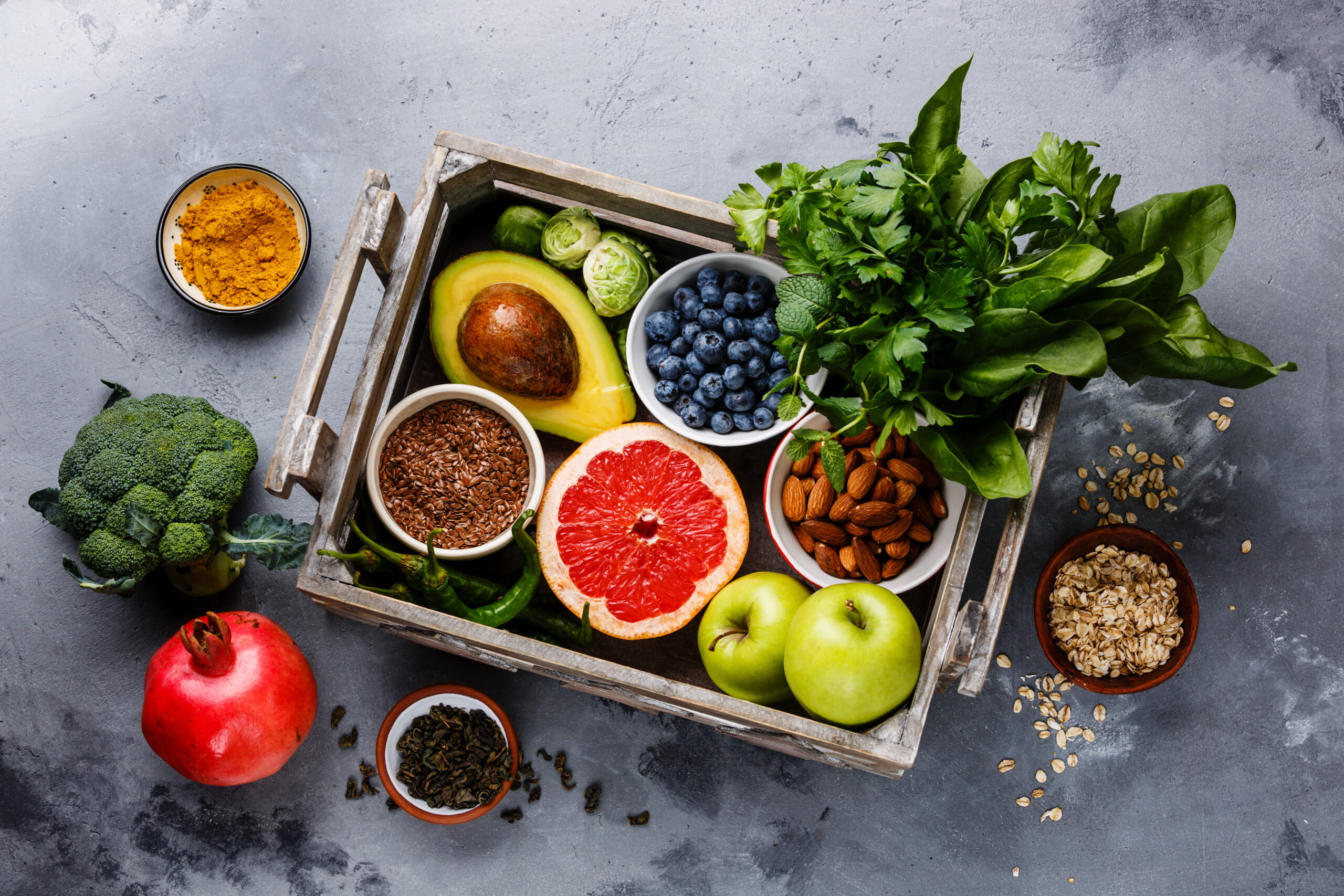
There are some basic fall practices that will bring you great pleasure because they involve such a delicious spectrum of foods. Think of this as Ayurvedic gastronomy: the art or science of good eating. But these practices also lend us the greatest amounts of balance, energy, and focus. Most of us are happier when we feel strong and clear, as opposed to spacey, indecisive, forgetful, and worrisome. So listen well and listen hard – this is going to be good and share the essentials to keep stocked in your kitchen!
Aim to have all six tastes present at each meal (sweet, sour, salty, bitter, pungent and astringent) – but focus most heavily on sweet, sour and salty foods. This means to focus on foods that are naturally in season at this time of year! Don’t you love how nature provides for us so perfectly?
Sweet fall foods include pumpkin, squashes, root vegetables, whole grains (quinoa and amaranth are the most warming), pears, persimmons, apples, whole milk dairy and fresh dates or figs. Cook your squashes and your roots.
Salty fall foods are most important for the person who deals with a dry/cold vata imbalance. Water follows salt so salt in this context is meant to hydrate – specifically good salt: Celtic sea salt, Himalayan pink salt, Fleur de sel, etc. Salts that are not bleached or processed but are whole – and balanced by minerals that naturally occur alongside sodium in the earth. Salt is particularly warm and unctuous (lubricating) when taken in moderate amounts.
Sour fall foods include lemons, whole milk yogurt, apple cider vinegar, ume plum vinegar and naturally fermented foods like raw sauerkraut. Truly ‘tis the time of year to jar up that fall harvest (make that last trip to the farmer’s market before it closes for the season!) and use sour foods medicinally at most meals.
In the fall, I like to start the morning with a cup of hot water and lemon. Lemons are heating and highly enzymatic, which makes them a little sharp, very digestive, somewhat laxative and a great tool for stimulating digestive fire and encouraging regularity – a real “woot woot!” for vatas. Lemons tend to have a detoxifying effect on the body.
Perhaps even more crucial than lemons alone for fall health is to feed your digestive fire (agni) regularly with plenty of digestive enzymes – here’s where spices come in – and plenty of probiotic, good bacteria-rich foods. Examples include raw sauerkraut, beet kvaas (a surprisingly delicious fermented beet juice that strengthens blood, detoxifies, liver and alkalizes the blood), and coconut kefir (just fermented coconut juice–almost nothing is easier).
Keeping our internal fire alive not only stimulates full and regular elimination, it also wards off depression, colds, and flu. Fall is, after all, lung and large intestine time. These sister organs work together and in harmony with each other. So the more you can remember to breathe, chew your food completely, and slow down enough to give thanks, the better you’ll feel.
Reduces Vata, Increases Pitta, Neither increases or decreases Kapha
Preparation time: 1 hour
Preheat the oven to 375 degrees. Wash and cut the fennel root, sweet potato, parsnip and leek. In a medium bowl, mix together the mustard, garlic and melted ghee. Grind the cereal until it’s pretty fine, something like breadcrumbs. In a separate medium mixing bowl, thoroughly combine the cereal, salt and spices.
Toss the veggies in the mustard mixture and stir so that each piece is coated with the sauce. Pour it all into the cereal mixture and stir again so that the vegetables are breaded. Lay the veggies in a single layer on a cookie sheet. Bake until the vegetables are golden brown, about 45 minutes.
Reduces Vata, Increases Pitta, balances Kapha.
Preparation time: 20 minutes
· 2 bunches fresh basil leaves
· 1 cup chopped fresh watercress or bok choy
· 1 inch fresh ginger root, peeled and minced
· 1/2 cup raw cashews or brazil nuts
· 1/4 cup coconut butter
· 1/2 cup raw tahini
· 2 Tbs chia seed
· 1 cup olive oil
· Juice of 1 lime
· 1 teaspoon salt
· 1 teaspoon ground nutmeg
· 1/2 teaspoon black pepper (omit for pitta)
· 1/2 teaspoon asafoetida (omit for pitta)
· 1 teaspoon celery seed or fennel seed
Chop the basil leaves, watercress and ginger root and set aside.
Place the cashews, coconut butter, raw tahini, chia seed, lime and 1/2 cup of the olive oil into a food processor or Vitamix. Process for 5 to 10 seconds, then add half of the fresh basil, watercress, and ginger root. Blend for 20 seconds. Add the remaining 1/2 cup of olive oil, the remaining fresh herbs, salt, nutmeg, black pepper, asafoetida and celery seed. Blend again for 2 full minutes. If your pesto is really thick, add another 1 to 2 tablespoons of olive oil until the consistency is smooth and creamy.
This pesto freezes well and will keep in the refrigerator for up to 3 weeks.
Note: Young coconut juice can be used in place of some or all of the olive oil to add a different element of hydrating nutrition. For Pitta, replace black pepper and asafoetida with an equal amount of cooling spices like dill, mint or ground coriander. Asafoetida is a salty, pungent spice most readily found in Indian markets, although some health food stores carry it as well.
Decreases Vata, Decreases Pitta, balances Kapha
Preparation Time: 15 minutes plus 2 days fermentation time
· 3 to 5 small to medium raw beets (yields about 2 cups)
· 2 teaspoons sea salt
· 1/4 cup whey (from yogurt, kefir, or raw milk – you can also find dairy-free kefir starters online – your kvaas may take longer to ferment)
· Filtered water
Peel and chop the beets, and put into a 2-quart glass container. Peeling them is crucial. Add the whey, salt, and water. Stir well and cover completely. Keep at room temperature for at least two days, longer if you live in a particularly cold climate. The taste and texture of your beet kvaas will be on the sour side and perhaps slightly carbonated when done. Store in the refrigerator.
For more ways to keep your kitchen stocked with healthy, seasonal food for your dosha, download my free guide below!
FREE GUIDE: STOCKING YOUR AYURVEDIC KITCHEN
With thanks to Talya Lutzker who is a Certified Ayurvedic Practitioner, nutritionist, chef, and yoga teacher, and the founder of Talya’s Kitchen. Her latest cookbook is The Ayurvedic Vegan Kitchen.
Learn more at TalyasKitchen.com.

The Holistic HIghway integrates traditional Western medical practices with Ayurveda medicine, creating a focus on prevention through nutrition, diet, and exercise; use of the latest genetic testing and other diagnostic techniques; and prescribed combinations of botanical medicines, supplements, therapeutic diets, detoxification programs, or stress-management techniques.

Integrative Health Expert | Ayurveda Practitioner | Author | Speaker
Kerry is a globally recognized leader in integrative medicine and the science of health known as Ayurveda. She is passionate about raising awareness of the need for a change in contemporary medicine that focuses on patient empowerment and a health-based (rather than disease-based) medical system.
Kerry is connected with The University of Pittsburgh Center for Integrative Medicine and remains a pioneer in the field of integrative medicine where she has developed a personalized system to manage chronic disorders by incorporating fundamental changes in diet, behavior, and stress while focusing on genetics.
This individualized program is so successful that many of her clients have achieved maximum healing and vitality after years of chronic problems!
More to Explore